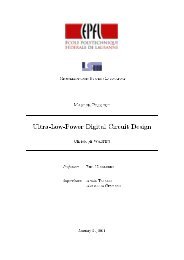Compressive Sensing system for recording of ECoG signals in-vivo
Compressive Sensing system for recording of ECoG signals in-vivo
Compressive Sensing system for recording of ECoG signals in-vivo
You also want an ePaper? Increase the reach of your titles
YUMPU automatically turns print PDFs into web optimized ePapers that Google loves.
It is worth mention<strong>in</strong>g that compressible <strong>signals</strong> are more realistic to consider than sparse<strong>signals</strong>, and under this condition even the l 0 -m<strong>in</strong>imizer does not match the signal exactly, sothere is no hope <strong>for</strong> the l 1 -m<strong>in</strong>imizer to be correct.Mathematicians have developed new faster algorithms to solve the l 1 -m<strong>in</strong>imization problem. Inthe [30] the ma<strong>in</strong> recovery algorithms are available to be downloaded.3. <strong>ECoG</strong> and AP <strong>Compressive</strong> <strong>Sens<strong>in</strong>g</strong> System Design3.1. Power Consumption AnalysisIn Appendix B, two models with an analog and digital approach to be applied over a similarneural acquisition <strong>system</strong> are <strong>in</strong>cluded. This comparison has been presented <strong>in</strong> [3], and it canbe considered the most significant example <strong>of</strong> power analysis <strong>of</strong> both, analog and digitalapproach, to the CS problem <strong>for</strong> neural <strong>signals</strong> compression <strong>in</strong> the limited exist<strong>in</strong>g literature.Due to this fact, this has been taken as the ma<strong>in</strong> reference to study the power consumption <strong>of</strong> amultichannel acquisition <strong>system</strong> and figure out which are the blocks susceptible to me improve<strong>in</strong> terms <strong>of</strong> power sav<strong>in</strong>g. As the bound <strong>of</strong> this project is to achieve a novelty <strong>in</strong> the analog pathimplementation <strong>for</strong> a CS <strong>system</strong>, the power analysis is focussed <strong>in</strong> the calculation considered <strong>in</strong>the analog implementation shown <strong>in</strong> Appendix B. These equations has been <strong>in</strong>ferred by tak<strong>in</strong>g<strong>in</strong>to account that as we are <strong>in</strong>tegrat<strong>in</strong>g over N samples, the <strong>in</strong>stantaneous voltage on the<strong>in</strong>tegrator can be expected to grow by an average factor <strong>of</strong> √N and cannot be allowed to exceedthe available maximum differential ADC <strong>in</strong>put range. This condition can be summarized <strong>in</strong> Eq.9:(9)By apply<strong>in</strong>g this condition, the result<strong>in</strong>g power ga<strong>in</strong> becomes NG 2 A <strong>in</strong>stead <strong>of</strong> G 2 A . However,contrary to what is stated <strong>in</strong> [3], as sparse <strong>signals</strong> are <strong>in</strong>tegrated, the growth factor <strong>of</strong> √N is anoverestimation <strong>of</strong> how the <strong>in</strong>tegrated signal can <strong>in</strong>crease, and consequently the total ga<strong>in</strong> canbe approximated depend<strong>in</strong>g on the output noise at the output <strong>of</strong> the <strong>in</strong>tegrator and the total ADCquantization noise which can be allowed <strong>in</strong> the path. That is expressed <strong>in</strong> Eq. 10:(10)By substitut<strong>in</strong>g this condition <strong>in</strong> the total power consumption estimation <strong>for</strong> a complete analogpath:(11)37















